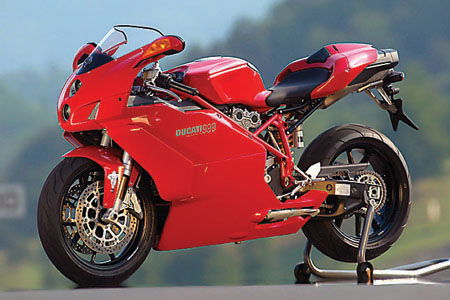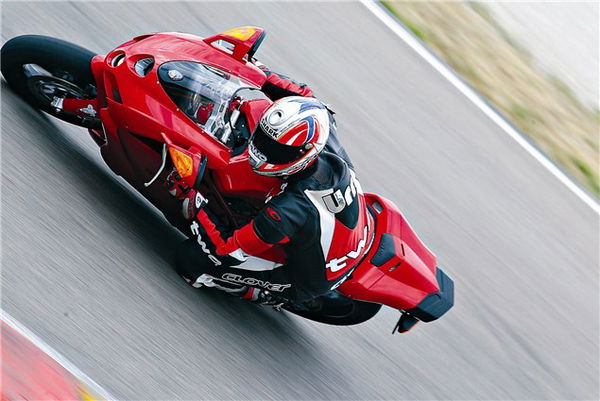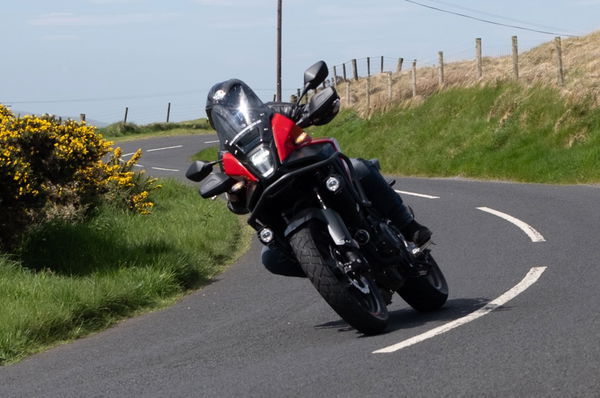First Ride: 2005 Ducati 999
Ducati's flagship sportsbike gets a new look as well as a whole load more power for 2005. Jon Urry samples the delights of the new 999

 |
DUCATI'S 999 HASN'T exactly set the world on fire since its launch in late 2002. While its predecessor, the 916, caused queues in dealers when it was launched in 1994, public reaction to Pierre Terreblanche's development of Massimo Tamburini's classic has been cool.
Despite the 999 actually selling more units in its first year than the 916 did, this statistic is skewed by the fact that very few 916s were actually available back then. By 2002 Ducati had sorted out its production lines and bikes were rolling off at a much higher rate.
Look at the UK sales statistics and you will find that last year - the 999's first full year of sales - a total of 469 bikes were sold, and that's including the S and R versions. In the same year, 124 998s were sold, while the year before 388 of the older style bikes were cleared from dealer's floors, despite the eight-year-old styling. Can you imagine an eight-year-old CBR600 almost matching the sales of the new CBR600RR?
And in 2004, things are even worse for Ducati. Just 276 999s have been sold up to August, compared to 115 of the 'old' 998s sold! Even combined, Ducati's superbike sales are a fraction of the 2176 new R1s sold this year.
"Things could always be better but it's unfair to say we are unhappy about the 999's sales," says a Ducati spokesperson when I quizz him about it, but he did look strangely unworried. And now I know why.
A few weeks ago Ducati launched an updated version of its homologation special 999R in America with a reworked top fairing and new engine internals (see over the page), claiming the changes were purely to give Eric Bostrom a few more bhp and a more slippery profile in the American AMA race series. But Ducati was pulling a flanker.
Just a week after the 999R's unveiling we received an invitation to the launch of an unspecified 999 at Mugello in Italy, which the Ducati men were keeping tight lipped about. Assuming it was a European spec 999R I was more than a little surprised when, sat in a pit garage at the track, a curtain dropped to the tune of Tina Turner's 'Simply the Best' revealing... a 999. But hang on a second.
A closer look revealed the new style front fairing is in place, but the bike beneath it isn't the all-singing R, but actually the stocker and base model 999. The 999 has received a facelift, but that's not all.
As well as the new-style top fairing, which is 10mm wider as well as being made of a lighter material, the screen is 20mm taller, the frame is painted to match the fairing (either red or black, the new colour option for 2005), the exhaust cover is now black, as are swingarm, wheels and subframe.
But it doesn't stop there. The stock 999 now gets a WSB-style swingarm made from cast and forged aluminium (the rest of the chassis is identical) as well as a re-worked motor. And here is where it gets interesting. The stock 999 now gets a claimed 140bhp. That's up 16bhp, along with 10lb.ft more torque at 80.2lb.ft! That's more than the 2004 999R!
To give it this extra boost, Ducati has given the 999 motor new cams with more lift and duration. This means the valves are open longer and wider, allowing more fuel into the motor, which makes more power. The bore, stroke, valve size and even compression ratio are the same as the 2004 999, but the crank is lighter and of a different design and it gets a race-style deep sump, first seen on the 996R.
What's the catch? Not the price; the new 999 costs the same £11,250 as the current 999. But the work to the motor has lost some of the current model's bottom end at the expense of top end power.
Is it noticeable when you ride it? Well, yes to be truthful. Pulling out of Mugello's pitlane I was in danger of stalling the 999 at low revs, although I was being overly cautious, partly because of the assembled Ducati staff but also because of the brand new tyres front and rear. Below 5000rpm the new motor is noticeably weaker than the 999S's I had ridden through the Alps a week before. It needs a slip of the clutch to get going but once on the move doesn't really cause many problems. And anyway, the extra power is worth the sacrifice.
The new engine pulls noticeably harder than the current model's while still retaining its smoothness. Most of the turns at Mugello are third gear with the engine revving low, or second with it spinning higher - neither of which scenario upset the Ducati. As long as the revs are over the 5000rpm mark it pulls cleanly and strongly, but get it above 8000rpm and it pulls even harder. Does it have a genuine 140bhp? I reckon it's close, nearer 135bhp at the rear but easily the most powerful twin around without spending silly money.
While I'm guessing not many of you reading this will have been lucky enough to ride around the Mugello circuit, I'm sure most of you will remember the GP there. It's at the end of the huge 1km Mugello straight where Shinya Nakano's tyre failed so spectacularly, and it's bloody fast. In a brave moment I glance down at the speedo to see it showing 157mph before the slight left kink over a hill and down the other side into the braking zone for the second gear first corner.
This demonstrates two things. Firstly, the 999 pulls strongly as it is still accelerating in top gear when I come to brake. And secondly, the brakes are stunning. Okay, it may lack the current trendy radials, but there is nowt wrong with the individual pad-per-piston Brembos and on this brave lap I'm braking at around the 200-meter board. That's around 200 meters to scrub off over 110mph, which the Ducati does easily and in total control.
Like the current bike, the chassis is brilliant, even when pushed hard. At the start of the day the bikes are fitted with the sporty but road-biased Michelin Pilot Power tyres, which are changed at lunch for the far sportier Pilot Race once we've worked out which way the track goes. Even with the extra grip offered by the Races there was little need to change the suspension, although a quick stiffen up on the preload front and rear helps. I also raise the rear ride height by a few mm to help it turn faster and with less effort through the multitude of chicanes.
Verdict
The restyle may be a sales-led decision but it works. The new look is far sleeker than the current 999 and the colour-matched frame helps add to the appeal, and that's before the engine changes. The new motor transforms the 999 into a bike that could always do with a few extra bhp to one that has just about the right amount. Fun but not intimidating and delivered in a smooth and controllable package with an excellent chassis. It may cost over £2000 more than, say, an R1 but at least it now comes closer to justifying the difference. The new fairing has a practical side as well as looking good. The mirrors, which used to be purely a cosmetic exercise, now show about 50% elbow and 50% road behind, thanks to the wider fairing. And the taller screen not only means you can see the top row of warning lights, which you can't on the old 999, but you can also tuck in behind it easily. While better styling will no doubt lead to better sales, this bike also offers more value for money than the old model, and that makes it a winner.
SPECS
TYPE - SUPERSPORTS
PRODUCTION DATE - 2004
PRICE NEW - £11,250
ENGINE CAPACITY - 998cc
POWER - 140bhp@9750rpm
TORQUE - 80.2lb.ft@8000rpm
WEIGHT - 186kg
SEAT HEIGHT - 780mm
FUEL CAPACITY - 17L
TOP SPEED - 175mph
0-60 - n/a
TANK RANGE - N/A

Ducati's 999 hasn't exactly set the world on fire since its launch in late 2002. While its predecessor, the 916, caused queues in dealers when it was launched in 1994, public reaction to Pierre Terreblanche's development of Massimo Tamburini's classic has been cool.
Despite the 999 actually selling more units in its first year than the 916 did, this statistic is skewed by the fact that very few 916s were actually available back then. By 2002 Ducati had sorted out its production lines and bikes were rolling off at a much higher rate.
Look at the UK sales statistics and you will find that last year - the 999's first full year of sales - a total of 469 bikes were sold, and that's including the S and R versions. In the same year, 124 998s were sold, while the year before 388 of the older style bikes were cleared from dealer's floors, despite the eight-year-old styling. Can you imagine an eight-year-old CBR600 almost matching the sales of the new CBR600RR? And in 2004, things are even worse for Ducati.
Just 276 999s have been sold up to August, compared to 115 of the 'old' 998s sold! Even combined, Ducati's superbike sales are a fraction of the 2176 new R1s sold this year.
"Things could always be better but it's unfair to say we are unhappy about the 999's sales," says a Ducati spokesperson when I quizz him about it, but he did look strangely unworried. And now I know why.
A few weeks ago Ducati launched an updated version of its homologation special 999R in America with a reworked top fairing and new engine internals (see over the page), claiming the changes were purely to give Eric Bostrom a few more bhp and a more slippery profile in the American AMA race series. But Ducati was pulling a flanker. Just a week after the 999R's unveiling we received an invitation to the launch of an unspecified 999 at Mugello in Italy, which the Ducati men were keeping tight lipped about.
Assuming it was a European spec 999R I was more than a little surprised when, sat in a pit garage at the track, a curtain dropped to the tune of Tina Turner's 'Simply the Best' revealing... a 999. But hang on a second. A closer look revealed the new style front fairing is in place, but the bike beneath it isn't the all-singing R, but actually the stocker and base model 999. The 999 has received a facelift, but that's not all.











